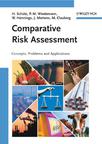比较风险评估
2006-12
John Wiley & Sons Inc
Hennings, Wilfried
217
Providing a catalogue of suggested solutions for different categories of issues, this book offers a balanced overview and methodological examples for the practical implementation of the CRA. It considers CRA in the USA, Europe and Germany, using case studies to analyze and exemplify the decision-making processes and challenges involved. The authors then go on to look at the practical lessons learned from these case studies, together with an in-depth discussion of the underlying scientific hypotheses. Sound scientific knowledge for everyone who makes decisions, whether government ministers, regulators, or company directors.
Holger Schütz a senior scientist in the MUT (Man, Environment and Technology) Program Group at the Jülich Research Center, focusing on risk perception and risk communication, comparative assessment of environmental health risks and evidence assessment.
Foreword. Acknowledgements. Summary. 1 Introduction. 2 Concepts and Definitions. 2.1 Risk. 2.2 Danger/Potential for Damage–Hazard. 2.3 Incertitude and Uncertainty. 2.4 Risk Assessment. 2.5 Risk Evaluation. 2.6 Risk Comparison. 2.7 Risk Management. 2.8 Risk Regulation. 2.9 Risk Communication. 3 CRA in Practice. 3.1 Political Environment of CRA. 3.1.1 CRA in the USA. 3.1.2 CRA in Europe. 3.1.3 CRA in Germany. 3.2 Project Case Studies. 3.2.1 US EPA Unfinished Business Project. 3.2.2 Comparative RiskFramework Methodology and Case Study(USEPA). 3.2.3 Global Burden of Disease (GBD) Study. 3.2.4 ExternE Project. 3.2.5 Comprehensive Assessment of Energy Systems Project. 3.2.6 Classification of Carcinogenic Airborne Pollutants for the German TA Air Novella. 3.2.7 Summary. 4 The Empirical Foundations of CRA. 4.1 A Starting Point for Risk Comparisons. 4.2 Risk Comparisons as a Means of Risk Communication. 4.3 Procedural Challenges. 4.3.1 Framework: What is to be Kept in Mind when Determining the Systems Limit Options for CRA? 4.3.2 Risk Categories: What Inf luence Do They Have on Comparisons? 4.3.3 Attributes: What Inf luence Do They Have on Comparisons? 4.3.4 Assessment of the Attributes: What Inf luence Does the Measure of a Risk Have on omparisons? 4.3.5 Comparsons: What Inf luence Does the Nature of the Comparison Have on the Comparison? 4.4 CRA Negotiations Under Conf lict. 4.4.1 Pitfalls in the Evaluation of One’s Own Position and Interests. 4.4.2 Pitfalls in the Evaluation of Other Parties. 4.4.3 Pitfalls in the Evaluation of Suggestions. 4.4.4 Pitfalls in the Evaluation of Outcomes. 5 Conceptual Framework for an Integrated Comparative Risk Evaluation. 5.1 Methodological Problems of a CRA. 5.1.1 Problem: Uncertainty and Incertitude. 5.1.2 Problem: Evaluative Criteria. 5.1.3 Consequences for the Conduct of a CRA. 5.2 Methodology of Comparative Risk Evaluation. 5.2.1 Multiattribute Risk Evaluation: Quantitative and Qualitative Approaches. 5.2.2 Conduct of a Multiattribute Evaluation. 6 The Practical Implementation of CRA. 6.1 Limits of Comparability. 6.2 Goals of a Comparative Evaluation of Risks. 6.2.1 Preliminary Analysis. 6.2.2 Risk Assessment. 6.2.3 Risk Evaluation. 6.2.4 Risk Management. 6.3 Participation Models. 6.4 CRA Participants. 6.5 The Sequence of Events in a CRA. 6.6 The Organization of Communication. Appendix 1: Risk Metrics. Appendix 2: Multiattribute Comparative Risk Evaluation (MCRA). Appendix 3: Comparative Evaluation of Unclear Risks. Appendix 4: Comparative Evaluation of the Risks of Hazardous Incidents. References. Abbreviations of Organizations. Index.
